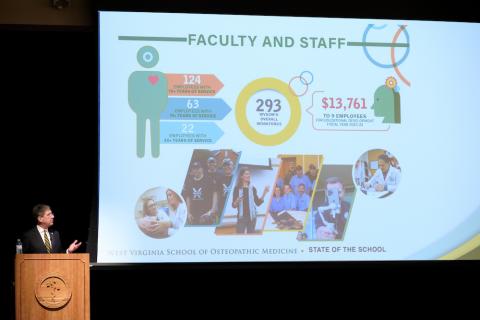2024 State of the School Address
WVSOM celebrates successes, prepares for challenges

LEWISBURG, W.Va. — The West Virginia School of Osteopathic Medicine (WVSOM) is celebrating its successes while focusing on the challenges of the future. President James W. Nemitz, Ph.D., delivered that message during his 2024 State of the School address during a campus assembly for faculty, staff and students in Lewisburg.
“I want to talk about our accomplishments and acknowledge all of you, because it’s your work, and show you where we’re really making progress. I also want to talk quite frankly about the challenges we face as an institution as we move forward,” Nemitz said.
Noting the school’s mission, Nemitz said WVSOM remains West Virginia’s leading producer of physicians practicing in the state. He shared 2023 data from the West Virginia Higher Education Policy Commission’s Health Sciences and Rural Health Report showing that, among the state’s three medical schools, WVSOM is the leader in three key physician categories: providing physicians who are practicing in rural areas of West Virginia, providing primary care physicians who are practicing in West Virginia and graduating students who stay in West Virginia to practice in any specialty.
“We have 81 new physicians in rural areas of this state — more than double what the other schools are doing,” Nemitz said, referring to the most recent six-year cohort of graduates completing residency.
Nemitz said there is a lot to be proud of at WVSOM as the school is the largest medical school in the state, offers the lowest medical school tuition in the state and generating an economic impact in the state of $1.5 billion.
Meeting the school’s mission and maintaining its role as a state leader in producing physicians are even more impressive, Nemitz said, considering the rapidly changing environment for medical schools and higher education.
During the first six years of his presidency, Nemitz said, the WVSOM campus community has experienced the COVID-19 pandemic, declining college student enrollment, changing public opinion of the value of higher education, rising student expectations of education offerings and facilities, increased competition for incoming medical students and the financial cost of all those elements.

Before detailing key issues, Nemitz applauded WVSOM’s Board of Governors, administration, faculty, staff and students for their support and commitment to the school.
“We are making a major contribution to West Virginia. As I go around the state — and as I work at the Capitol with our legislature — they know who we are. They comment, ‘You produce great graduates. My physician is a graduate of your school. You are doing a great job.’ I want you to know that you are part of that success,” Nemitz said.
Nemitz also thanked West Virginia Gov. Jim Justice and the West Virginia Legislature for supporting the school, including last year’s appropriation of $29 million for a new medical research center.
Such commitment and investment are needed, he said, to ensure WVSOM’s continued growth and success.
Nemitz said a vital part of the president’s job is preparing the school for the future, explaining that change and challenges are coming so rapidly that he has ordered the development of a new strategic plan for the school. Nemitz outlined some of his priorities for 2024, including finalizing the new strategic plan, supporting WVSOM’s admissions staff, addressing campus security needs, working with the Marketing and Communications Department to promote the school and focusing on what makes WVSOM distinctive.
Nemitz said the school’s new “Finding Health” curriculum, the opening of a new Testing Center, increased use of virtual reality in instruction, the addition of a Master of Science in Biomedical Sciences degree program, and areas of study such as wilderness medicine, culinary medicine and exercise in medicine will make the school more attractive to potential students.
He said WVSOM must also recognize its challenges, face them head on and turn them into opportunities.
Nemitz said WVSOM’s most critical function, and a current challenge, is admissions. His administration is studying how the undergraduate student decline will impact medical school admissions and monitoring enrollment trends in West Virginia.
He said in the next decade there will be fewer traditional college-going students and fewer people who want to spend the money to attend college, adding that undergraduate schools are already being affected.
Among the trends Nemitz noted are an anticipated 21% decline in high school graduates between 2021 and 2036, an anticipated 6.5% decline in the college-going rate in West Virginia and expansion of osteopathic medical schools in western Pennsylvania and western Maryland, which are traditional recruiting areas for WVSOM.
Nemitz noted that new osteopathic medical schools, while beneficial to the profession, will impact WVSOM’s enrollment and its ability to recruit quality faculty and staff and find clinical rotations for students.
Nemitz said persuading more potential students to visit the WVSOM campus is important.
“There are plenty of medical school applicants out there. We just have to convince them to come here. We can do that, and we are doing that. If we can get them to visit our campus, we know that is a major selling point,” he said.
“We are a success. We are in a good position. We are ready to meet our challenges,” Nemitz said.